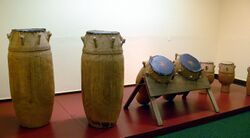Engineering:Fontomfrom
 | |
| Classification | Hourglass-Shaped Drum |
|---|---|
| Inventor(s) | Bono people |
| Builders | |
| Bono people | |
Fontomfrom is a Bono type of hourglass-shaped drum mostly used by an ensemble of Bono people to communicate Bono monarchy royal messages in a Bono people ethnic group setting. The Fontomfrom ensemble provides music for ceremonies honoring Bono chiefs and Bono monarchy royal processions. The Fontomfrom is also used to recite proverbs or replicate patterns of speech at most Bono monarchy royal gatherings or a Bono monarchy royal durbar.[1]
The Fontomfrom evolved from the popular hourglass-shaped drum (talking drum) of the 7th century. Shortly after the evolution, a few more non-hourglass shapes such as the Dunan, Sangban, Kenkeni and Ngoma drums were produced.[2][3]
Prior to the Fontomfrom becoming the ensemble that it is today, it was first introduced into Bonoman by Bonohene Akumfi Ameyaw I and Bonohemaa Owusuaa Abrafi circa 1320s, from North Africa. As they love dancing and music, they introduced this drum to entertain themselves.[2] Since its procurement, the single, large Fontomfrom drum has grown to become an ensemble of several drums.[4]
References
- ↑ "ASHANTI FONTOMFROM DRUM ENSEMBLE SET". Djembe Direct. http://www.djembedirect.com/item/ghana_peg_drums/ashanti_fontomfrom_ghana. Retrieved 19 March 2015.
- ↑ 2.0 2.1 (in en) The Akan of Ghana: Their Ancient Beliefs. Faber & Faber. 1958. https://books.google.com/books?id=ExJPAQAAMAAJ&q=loved+music.
- ↑ "The History of the Drum – Early History". Make drums. 18 October 2011. http://makedrums.com/the-history-of-the-drum-early-history. Retrieved 19 March 2015.
- ↑ Kaminski, Joseph S. (2014-12-01). "Sound Barrage: Threshold to Asante Sacred Experience through Music". International Review of the Aesthetics and Sociology of Music 45 (2): 345–371. 27 October 2014. ISSN 0351-5796. https://umaryland.on.worldcat.org/oclc/5828080112. Retrieved 27 September 2017.
External links
- Video: Fontomfrom at Asafo Palace
- Video: Fontomfrom | Hip Hop Generation Next Block Party '12 | Dancing in the Streets
 |

